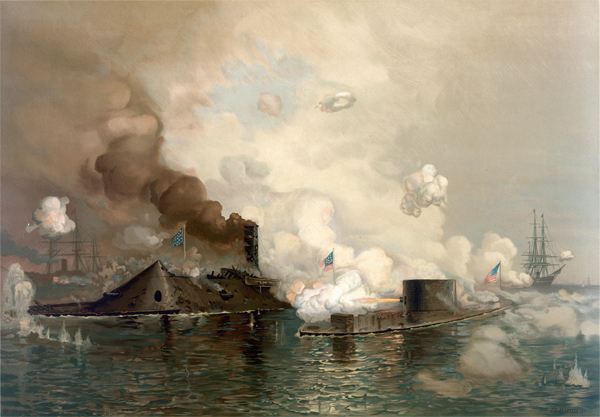
U.S.S. Monitor sinks on December 30, 1862
U.S.S. Monitor sinks: On this day in 1862, the U.S.S. Monitor sinks in a storm off Cape Hatteras, North Carolina. Just nine months earlier, the ship had been part of a revolution in naval warfare when the ironclad dueled to a standstill with the C.S.S. Virginia (Merrimack) off Hampton Roads, Virginia, in one of the most famous naval battles in American history - the first time two ironclads faced each other in a naval engagement.
After the famous duel, the Monitor provided gun support on the James River for George B. McClellan's Peninsular Campaign. By December 1862, it was clear the Monitor was no longer needed in Virginia, so she was sent to Beaufort, North Carolina, to join a fleet being assembled for an attack on Charleston, South Carolina. The Monitor served well in the sheltered waters of Chesapeake Bay, but the heavy, low-slung ship was a poor craft for the open sea.
The U.S.S. Rhode Island towed the ironclad around the rough waters of Cape Hatteras. Since December is a treacherous time for any ship off North Carolina, the decision to move the Monitor could be considered questionable. As the Monitor pitched and swayed in the rough seas, the caulking around the gun turret loosened and water began to leak into the hull. More leaks developed as the journey continued. High seas tossed the craft, causing the ship's flat armor bottom to slap the water. Each roll opened more seams, and by nightfall on December 30, the Monitor was in dire straits.
The Monitor's commander, J.P. Bankhead, signaled the Rhode Island that he wished to abandon ship. The wooden side-wheeler pulled as close as safety allowed to the stricken ironclad, and two lifeboats were lowered to retrieve the crew. Many of the sailors were rescued, but some men were terrified to venture onto the deck in such rough seas. The ironclad's pumps stopped working and the ship sank before 16 crew members could be rescued.
Although the Monitor's service was brief, it signaled a new era in naval combat. The Virginia's arrival off Hampton Roads terrified the U.S. Navy, but the Monitor leveled the playing field. Both sides had ironclads, and the advantage would go to the side that could build more of them. Northern industry would win that battle for the Union.
History Channel / Wikipedia / U.S.S. Merrimack - CSS Virginia (1862-1862) Navy.mil / Civil War.org
Image: ● Lincoln Memorial; an American national monument built to honor the 16th President of the United States, Abraham Lincoln - located on the National Mall in Washington, D.C. across from the Washington Monument.
● The northern army led by George McClellan and the southern army led by Robert E. Lee met at Antietam Creek, Maryland in September, 1862. It was a bloody battle where 13,000 Confederates and 12,000 Union troops died in just one day. McClellan had hesitated to attack before the battle thus letting the southern troops regroup. Also, he had saved reserves and refused to use them at the end of the battle thinking that Lee was holding reserves for a counterattack, even though those reserves didn't exist. The Union victory stopped Lee's northward advance and was a turning point in the war.
● Battle of Antietam / Stone Bridge at Antietam Battlefield - Sharpsburg, Maryland
● First Battle Between Ironclads: CSS Virginia/Merrimac (left) vs. USS Monitor, in 1862 at the Battle of Hampton Roads.
● Although photography was still in its infancy, war correspondents produced thousands of images, bringing the harsh realities of the frontlines to those on the home front in a new and visceral way. The Atlantic.
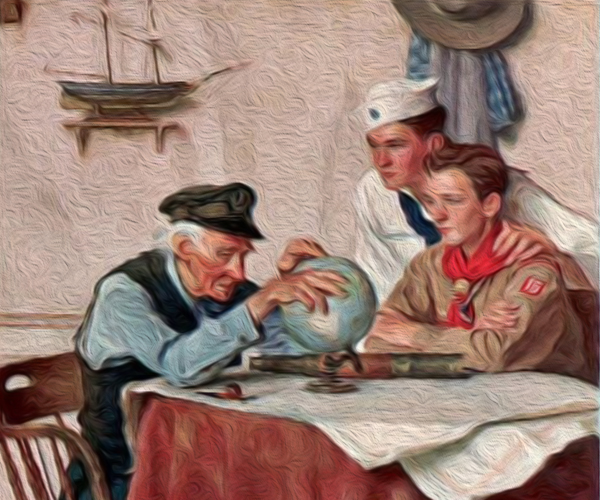
Understanding Military Terminology - foreign object damage
(DOD) Foreign object damage:
Rags, pieces of paper, line, articles of clothing, nuts, bolts, or tools that, when misplaced or caught by air currents normally found around aircraft operations (jet blast, rotor or prop wash, engine intake), cause damage to aircraft systems or weapons or injury to personnel. Also called FOD. Wikipedia / Joint Point 3-04)

The Old Salt’s Corner
Flight Deck Jersey Colors
While watching flight operations on the carrier you will notice several different types of crew supporting the aircraft on deck. These crews each wear a different color jersey to identify their function.
Jersey Colors
RED: Ordnancemen, repair parties and fire fighters.
BLUE: Aircraft handling, chockman, and elevator operators.
GREEN: Aircraft maintenance men.
YELLOW: Aircraft movement directors and catapult officers.
BROWN: Plane captains.
PURPLE: Fuelers who refuel aircraft between missions.
WHITE: Other (medical team, air wing LSOs, sighting teams, safety personnel, and visitors).

“I’m Just Sayin’”
What do people in China call their good plates?

“Thought for the Day”
“It is better to be defeated on principle than to win on lies.”
~ Arthur Calwell

“What I Have Learned”
“In order to succeed, you must first believe that you can.”
~ Nikos Kazantzakis

Bizarre News (we couldn’t make up stuff this good – real news story)
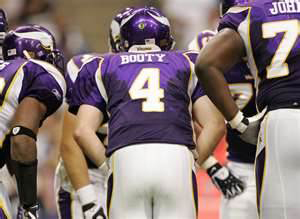
Just Possibly Racist: One of the questions offered in testing by the Charlotte-Mecklenburg (North Carolina) school district for high school biology in November sought students' understanding of dominant and recessive genes with this puzzle:
“LaShamanda has a heterozygous big bootie, the dominant trait. Her man Fontavius has a small bootie which is recessive. They get married and have a baby named LaPrincess. What is the probability that LaPrincess will inherit her mama's big bootie?”
(Charlotte TV station WBTV was unable to confirm that the school system created the question, even though the question was apparently distributed with other system materials.)WBTV Charlotte 

Mr. Answer Man Please Tell Us: What causes vapor trails from jets?
There are three things about jet airplanes that help to understand vapor trails, also known as condensation trails or contrails.
First, a gallon of jet fuel is made up of molecules that are carbon chains. When the fuel burns in the engine, the carbon atoms in the chain combine with oxygen atoms in the air to create carbon dioxide (CO2). The hydrogen atoms combine with oxygen to form water (H2O). In rough terms a gallon of jet fuel produces approximately a gallon of water when it burns, but that water is hot steam as it comes out of the engine.
Second, a big jet burns lots of jet fuel. A 747 is burning about a gallon of fuel every second. So there is a gallon of water exiting the engines every second in the form of steam.
Third, at 30,000 feet the air temperature might be -40 degrees F . So the steam comes out of the engine, condenses into water and freezes into ice almost instantly. The vapor trail you see is that condensation, known as a condensation trail.
Research: Wikipedia
• NOAA
• NASA
• Contrail Science 

Where Did That Saying Come From?

“Cold Turkey:”
The origin of “cold turkey” is not entirely certain, but the phrase seems to have evolved from the older (19th century) classic American idiom “to talk turkey”, meaning “to speak directly and frankly, without beating around the bush.”
There are a number of stories about the origin of “talk turkey”, many of which involve Pilgrims and Indians. An early form of the phrase was “to talk cold turkey”, most likely using “cold turkey”, a simple, uncomplicated meal, as a metaphor for simple, unadorned, direct speech.
With “talk cold turkey” already a popular idiom meaning “give it to me straight; tell me the unvarnished truth”, it seems natural that “cold turkey” came to mean “quit suddenly, with no tapering off or equivocation.” Wikipedia

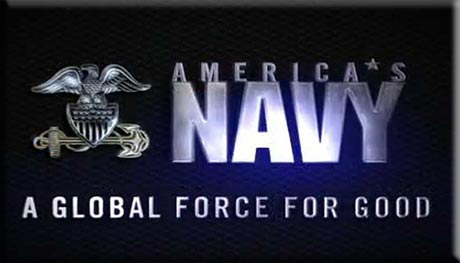
NAVSPEAK aka U.S. Navy Slang
EMI: Extra Military Instruction. Extra work, usually as dirty as possible, assigned as punishment for minor infractions.
Goes Away: What happens to an enemy aircraft when it is hit by a missile.
OS trainer: derogatory term for a large Popsicle. Apparently, Operations Specialists are expected to “brown-nose” with officers more than other ratings which is not true, they just sit around laughing at all the grunts on the flight deck while sipping lemonade.
Workups: 1- to 6-week periods preceding a deployment during which the ship and/or its airwing practice and prepare. Widely known workups involving the carrier and the airwing are TSTA, COMPTUEX, JTFX and RIMPAC. Airwing only workups include trips to NAS Fallon and NAS Key West.
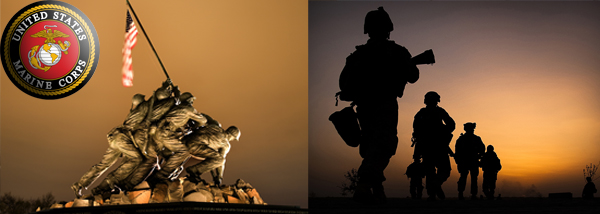
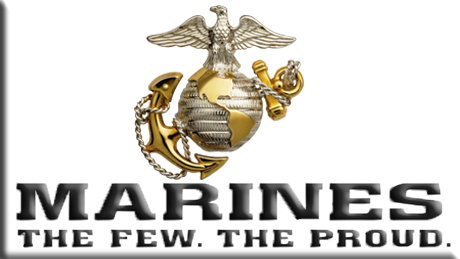
Just for you MARINE
Cool Beans: Everything is OK.
Cop: To get, as in “cop some Zs”.
Corfam® A material used to make dress shoes and boots that has a high gloss finish. See Spit Shine. A registered product of the DuPont Company.

Navy Acronyms
PFA - Physical Fitness Assessment
A required basic physical test conducted to determine the physical fitness of Navy personnel.
PI - Personal Inspections
An inspection of a recruit’s personal appearance and uniform.
PIR - Pass-in-review
Boot Camp graduation.
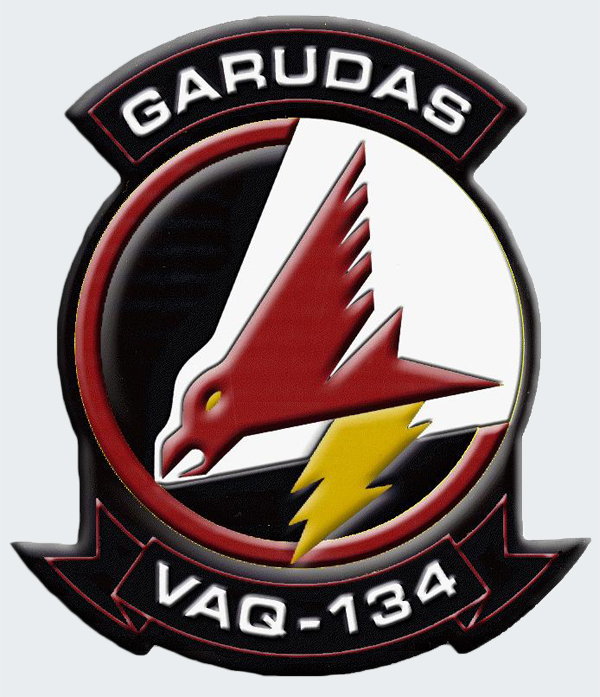
Naval Aviation Squadron Nicknames
VAQ-134 - Electronic Attack Squadron 134: “Garudas”
NAS Whidbey Island, Washington

The Strange, Mysterious or Downright Weird
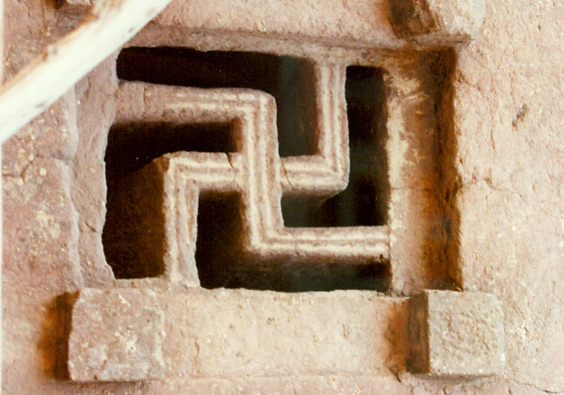
The Swastika was a commonly used (and positive) symbol
The swastika has been around for 3000 years and was a symbol of hope and luck, used frequently by Buddhists, Hindus and Native Americans. Even in the years before the Nazi party came to power, it was featured as a symbol in American uniforms during the First World War, in Coca Cola advertisements and even in sports teams such as the Edmonton Swastikas (pictured above). It is currently outlawed in Germany and many other countries.
BBC / History 1900s / The Holocaust Encyclopedia / Wikipedia

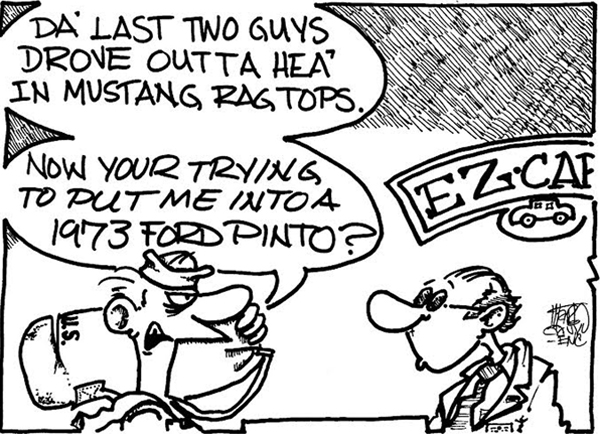
SONG FACTS
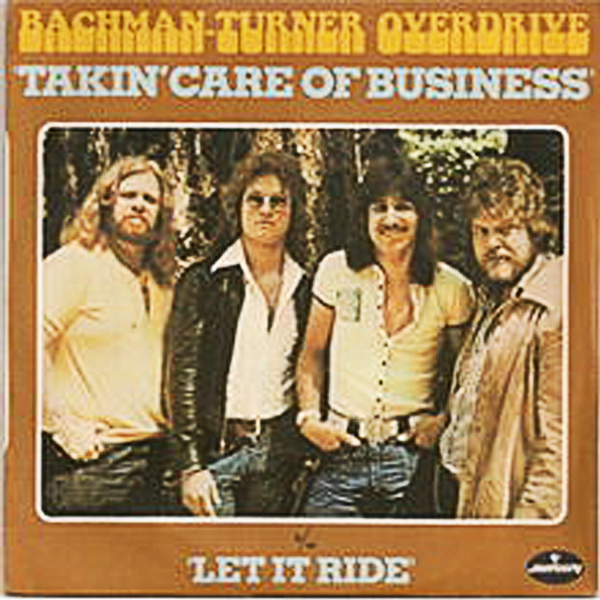
“Takin' Care Of Business” - Bachman-Turner Overdrive
Album: Bachman-Turner Overdrive II
Released 1973 
This song was written by Randy Bachman, who also sang lead on the track. He explained to classicbands.com that he came up with the idea for the song in the late-'60s while he was still a member of The Guess Who. Bachman loved “Paperback Writer”  by The Beatles, and he used that music to create a song about going to work called “White Collar Worker”, which needed a new hook to complete. The song lay dormant until Bachman formed Bachman-Turner Overdrive and were playing a show when lead singer Fred Turner's voice gave out. Forced to sing for a set, Bachman told the band to “Play these 3 chords over and over, C, B flat, and F endlessly and when I get to the hook, help me out.”
by The Beatles, and he used that music to create a song about going to work called “White Collar Worker”, which needed a new hook to complete. The song lay dormant until Bachman formed Bachman-Turner Overdrive and were playing a show when lead singer Fred Turner's voice gave out. Forced to sing for a set, Bachman told the band to “Play these 3 chords over and over, C, B flat, and F endlessly and when I get to the hook, help me out.”
Bachman was listening to C-Fox radio on the way to the club and heard the DJ say they were “Takin' Care of Business”, which gave him the idea for the hook. Singing his lyrics to “White Collar Worker”, Bachman sang “Takin' Care of Business” in the breakdown, and he had his song.
The band captured the feel of jamming in the club by having Bachman sing it, which Turner appreciated since it would give his voice a rest at their shows. Bachman had a sore throat and a head cold when he recorded his vocals.
The song propelled the phrase “Takin' care of business” into the popular lexicon, forever to be used by athletes, performers and the common man to indicate they are on the job.
Randy Bachman: “Ralph (Murphy) and I wrote a song in '67 called 'A Little Bit Of Rain'  .
That riff is used in the middle of 'Takin' Care Of Business', just to break the monotony because 'Takin' Care Of Business'
.
That riff is used in the middle of 'Takin' Care Of Business', just to break the monotony because 'Takin' Care Of Business'  was three chords over and over and over. It had no bridge. No hook. No song format, other than that it was 'Louie Louie'
was three chords over and over and over. It had no bridge. No hook. No song format, other than that it was 'Louie Louie'  . Endless, mind-bashing of three chords. And the original version, as I explained at the Ryman, had twelve chords. That's why nobody liked it. It had an incredible number of chords.”
. Endless, mind-bashing of three chords. And the original version, as I explained at the Ryman, had twelve chords. That's why nobody liked it. It had an incredible number of chords.”
While the song title implies an industrious responsibility, a closer listen reveals that this song is more of a slacker anthem. The singer is presumably unemployed, and he “loves to work at nothing all day”.
Norman Durkee played the piano on this track. So who is this Norman fellow? John Presho, who knew Bachman and worked security at their concerts, gives this account:
“Randy Bachman told me that when BTO was in the recording studio the record producer wasn't happy with the raw version of that song. BTO took a time out, ordered a pizza and went back to work on the song. A while later there was a knock on the studio door and it was the pizza delivery man. After giving the band their pizza he commented that 'Takin' Care of Business' was a great song but it needed some piano playing. The pizza man introduced himself as Norman and said that he was a piano player. BTO thanked and tipped him and sent him on his way. Hours later with no improvement in the song they decided to call Norman, but no one got his phone number or could remember the name of the pizza place. BTO called a half dozen pizza houses before they were able to track him down. The band paid Herman's $75 to join the musicians union so he could play the piano in the recording studio.”
Throughout the early '90s, this was used in commercials for Office Depot  to promote their business services. Hillary Clinton used it at many of her campaign events in 2008 when she ran for president of the US.
to promote their business services. Hillary Clinton used it at many of her campaign events in 2008 when she ran for president of the US.
This holds the record for largest guitar jam in history. On May 7, 1994, Bachman led 1,322 mostly-amateur guitarists in a performance of this that lasted 68 minutes. The event was held in Vancouver.
The Guess Who played this on their 2000 reunion tour. Bachman was in The Guess Who before leaving to form Bachman-Turner Overdrive.
Bachman's autobiography is titled Randy Bachman, Takin' Care Of Business.
Song Facts / Rolling Stone Magazine (332 of 500 Greatest Songs of All Time) / Wikipedia / Bachman and Turner.com / Rock & Roll Hall of Fame / All Music
Image: Takin' Care Of Business by Bachman–Turner Overdrive

Trivia
● A wolf's odor detecting ability is 100 times greater than mans.
● A pin-up photo of Rita Hayworth adorned the first test bomb dropped on Bikini atoll in the Marshall Islands in July 1946.
● The king of hearts is the only king without a moustache on a playing card.

A Test for People Who Know Everything
Who was the first Major League Baseball player to earn one million dollars in a single season?
● Answer for People Who Do Not Know Everything, or Want to Verify Their AnswerSABR.org
Answer to Last Week's Test
What brand of cigarette did cartoon cavemen Fred Flintstone and Barney Rubble smoke on the TV’s THE FLINTSTONES?
Answer: Winston, which sponsored the show during its first two seasons 1960-62.

Joke of the Day
A lawyer and two friends, a Rabbi and a Hindu holy man, had car trouble in the countryside and asked to spend the night with a farmer.
The farmer said “There might be a problem; you see, I only have room for two to sleep, so one of you must sleep in the barn.”
“No problem”, chimed the Rabbi, “My people wandered in the desert for forty years, I am humble enough to sleep in the barn for an evening.”
With that he departed to the barn and the others bedded down for the night.
Moments later a knock was heard at the door; the farmer opened the door. There stood the Rabbi from the barn.
“What's wrong?” asked the farmer.
He replied, “I am grateful to you, but I can't sleep in the barn. There is a pig in the barn and my faith believes that is an unclean animal.”
His Hindu friend agrees to swap places with him. But a few minutes later the same scene reoccurs. There is a knock on the door.
“What's wrong, now?” the farmer asks.
The Hindu holy man replies, “I too am grateful for your helping us out but there is a cow in the barn and in my country cows are considered sacred. I can't sleep on holy ground!”
Well, that leaves only the lawyer to make the change. He grumbled and complained, but went out to the barn.
Moments later there was another knock on the farmers door.
Frustrated and tired, the farmer opens the door, and there stood...
The pig and the cow.


























